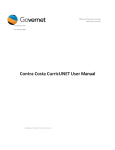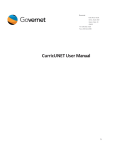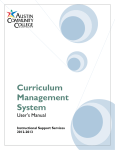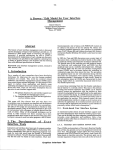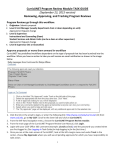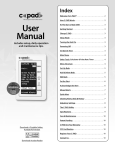Download CurricUNET User`s Manual
Transcript
1000 River Walk Drive, Suite 350 Idaho Falls, ID 83402 Tel: 208.522.1225 Fax: 208.522.2896 SJCC CurricUNET User Manual Building the Worldwide Curriculum Network Page 1 Table of Contents Log In ............................................................................................................................................................. 4 Viewing Courses & Programs ........................................................................................................................ 5 Courses...................................................................................................................................................... 5 Programs ................................................................................................................................................. 10 Proposals ..................................................................................................................................................... 15 New Course Proposal .............................................................................................................................. 16 Main .................................................................................................................................................... 18 Units/Hours/Content .......................................................................................................................... 20 Student Learning Outcomes ............................................................................................................... 22 Textbook ............................................................................................................................................. 24 Library Resources (other than textbooks) .......................................................................................... 29 Homework........................................................................................................................................... 30 Advisory/Recommended Prep ............................................................................................................ 31 Requisites ............................................................................................................................................ 33 Method of Instruction ......................................................................................................................... 36 Grading ................................................................................................................................................ 37 Material Fees ...................................................................................................................................... 39 Course and Program Status ................................................................................................................ 41 Course and Program Status – Transfer Info ........................................................................................ 42 General Education Status.................................................................................................................... 44 Distance Education ............................................................................................................................. 46 Codes/Dates ........................................................................................................................................ 48 Program Review and Reports ............................................................................................................. 49 Proposal Launch .................................................................................................................................. 51 Modify Course Proposal .......................................................................................................................... 52 Deactivate Course Proposal .................................................................................................................... 56 New Program Proposal ........................................................................................................................... 59 Main .................................................................................................................................................... 61 Description .......................................................................................................................................... 62 Learning Outcomes (PLOs) .................................................................................................................. 63 Course Blocks ...................................................................................................................................... 65 Page 2 Attach Files .......................................................................................................................................... 70 Codes................................................................................................................................................... 72 Program Proposal Reports .................................................................................................................. 73 Proposal Launch .................................................................................................................................. 75 Modify Program Proposal ....................................................................................................................... 76 Deactivate Program Proposal ................................................................................................................. 80 Approvals .................................................................................................................................................... 83 Back to Table of Contents Page 3 Log In Website: sjcc.curricunet.com Email: [email protected] Password: your password (will be ChangeMe44 until you change it) Enter your email and password credentials as shown below, and then click the green “Login” button. Back to Table of Contents Page 4 Viewing Courses & Programs Courses After logging in, you will arrive at the “Courses” page. The default is “My Courses”. In “My Courses” you are able to view and search the courses that you are currently working on, courses you have started, and course for which you are a co-contributor. To view all courses at SJCC, select “My Institution”. To search within courses, either on the “My Courses” or “My Institution” pages, use the dropdown menus to select the course Subject(s) and Status(es). You may also enter the course number or title keywords in the search bar. After you make your selections, click “Search”. You will need to manually close the dropdown menus once your search is complete. Back to Table of Contents Page 5 You can also sort courses by clicking on the column headings. For each course, you can view reports, by clicking on the page icon in the “Reports” column. A dropdown menu will open, allowing you to select from “Course Outline”, “Comparison”(when available), “Impact”, and “All Fields” reports. Each report will open in a new tab within your internet browser. The “Course Outline” report produces a course outline. Back to Table of Contents Page 6 The “Comparison” report shows all fields in the proposal, with differences between this course and any previous versions of this course highlighted and the items changed with a strike through. The “Impact” report shows interactions between this course and programs or other courses across the institution. Back to Table of Contents Page 7 The “All Fields” report shows all the fields that are on the course forms. Back to Table of Contents Page 8 To view a course, click on the course itself. This will bring you to the Course Proposal. On the Course Proposal page, you can move between sections of the proposal by using the dark gray tabs on the left of the page. If you have the authority to make changes to the proposal, you can do so here. For more information about the function of these tabs, see the “New Course Proposal” section of this guide. Back to Table of Contents Page 9 Programs To view programs, select the “Curriculum” button at the top of the page, then select “Program” from the dropdown menu. You will arrive at the “My Programs” page, where you can view any programs you have ownership of. To view all programs, select “My Institution” and “Search”. To search within programs, use the drop down menus to select the category(s) you would like to view. You will have to scroll down to view all departments. Back to Table of Contents Page 10 Manually close the dropdown menus by clicking the down arrow, enter any additional title keywords into the “Title” field, and click “Search”. To view a program, click on the program title. You can also sort programs by clicking on the column headings. For each program, you can view reports, by clicking on the page icon in the “Reports” column. A dropdown menu will open, allowing you to select from “All Fields”, “Program Outline”, and “Comparison” reports. Each report will open in a new tab within your internet browser. Back to Table of Contents Page 11 The “All Fields” report produces a report detailing each field within the program proposal. The “Program Outline” report produces a program outline, focusing on the Description, Program Learning Outcomes, and Degree Requirements. Back to Table of Contents Page 12 The “Comparison” report shows all fields in the proposal, with differences between this program and any previous versions of this program highlighted. The information that was changed will have a strike though. Back to Table of Contents Page 13 To view a program, click on the program itself. This will bring you to the Program Proposal. On the Program Proposal page, you can move between sections of the proposal by using the dark gray tabs on the left of the page. If you have the authority to make changes to the proposal, you can do so here. For more information about the function of these tabs, see the “New Program Proposal” section of this guide. Back to Table of Contents Page 14 Proposals To create a new proposal, click the “Create Proposal” button at the top of the page. You can do this from any page on the site. In Step 1, you will select the proposal type. Back to Table of Contents Page 15 New Course Proposal Select “New Course” from the Proposal Type dropdown menu in Step 1, then press “Next Step”. In Step 2, select the course subject from the dropdown menu, then enter the course number, title, and description, and enter “Next Step”. Mandatory fields are marked with an *. Back to Table of Contents Page 16 In Step 3, review the information you entered. If it is incorrect, click on any previous step to correct that information. If it is correct, click “Create Proposal”. Back to Table of Contents Page 17 Main The Course Proposal opens to the “Main” section. Any required field is marked with an *. Move between sections using the dark gray tabs to the far left. Sections with required fields also have an orange box showing your progress , which will turn green when you have completed all required fields. After completing all fields in the “Main” section, save any changes, and click the “Units/Hours” tab. You will only be prompted to save if changes are made. You will need to scroll down to view all fields within this section. Complete as much information as possible. Required fields are marked with an * and highlighted light orange. Several of the text boxes in this proposal section contain formatting tools, allowing you to, among other things, italicize text or format information into an outline. When you have completed all fields, save your work, then click on the “Program Outcomes” tab. Special Editing Tools Text Alignment Tools, including outline tools Text Appearance Tools Back to Table of Contents Page 18 If this course is the “Same As” or “Replaces” another course at SJCC, be sure to indicate which course(s). Use the dropdown menus to select the first semester and year that this applies. After the “Main” section is complete, save your work, and move to the “Units/Hours/Content” section by clicking the dark gray tab. Back to Table of Contents Page 19 Units/Hours/Content In the “Units/Hours/Content” section, use the dropdown menus to indicate the Delivery Method and Method of Instruction for this course. Next, enter the units and hours for the course. If the course has variable units or hours, click the box next to “Course has variable units?”. Making this selection will open a new area, allowing you to enter the Maximum Units/Hours. (Enter the Minimum in the previous fields). Back to Table of Contents Page 20 Use the formatting tools in the Course Lecture Content and Course Lab Content text boxes to enter the outline(s) for this course. Complete this section as thoroughly as possible, then save your work and move to the “Student Learning Outcomes” tab. Back to Table of Contents Page 21 Student Learning Outcomes In the “Student Learning Outcomes” section, you will provide information detailing the student learning outcomes. Click “Add New SLO” to add a student learning outcome. Enter each SLO individually in the text box labeled “Enter one SLO”, and then select the Assessment Methods for this SLO. You will need to scroll down to access all Assessment Methods. Click “Save” to add the SLO to the proposal. Back to Table of Contents Page 22 To edit a Student Learning Outcome, click the blue bar containing the outcome. To reorder the SLOs, use the up and down arrows on the right of the bar, or, to delete, click the red “x”. After all Student Learning Outcomes are entered individually and in the correct order, select the “Textbook” tab. Back to Table of Contents Page 23 Textbook In the “Textbook” section, you will provide information on textbooks and other materials required or optional for the course. Each text or material must be added individually and within the appropriate category. Click “Add new record” under the appropriate category to add a text or other material. Back to Table of Contents Page 24 Enter as much information about each material and type of material as possible. Indicate if this material is required by checking the checkbox, then complete, at minimum, all required fields, marked with an * and highlighted. After the information is complete, click “Insert”. Back to Table of Contents Page 25 In the Textbook category, if the Year of Publication entered is older than 5 years, you will be instructed to add a “Rationale for older textbook”. This field will only appear if the system recognizes the Year of Publication as prior to the appropriate year. Back to Table of Contents Page 26 In the “Text Other” category, enter information about any required materials required that do not fit in any other category. This might include supplies or uniforms. Back to Table of Contents Page 27 After you have entered the texts and other materials individually and in the appropriate categories, click “Edit” to make any necessary changes. Within each category, you may reorder the materials by clicking the column headings. If you have many materials, use the arrows under “Add new record” to browse through the materials. After all Textbooks and other materials are complete, move to the “Library Resources (other than textbooks)” section. Back to Table of Contents Page 28 Library Resources (other than textbooks) In the “Library Resources” section of the proposal, use the dropdown menu to select the Library materials/resources assessment. If new library materials are required, enter details about requested materials in the Item(s) textbox. Provide as much information as possible, then save your changes, and move to the “Homework” tab. Back to Table of Contents Page 29 Homework In the “Homework” section, provide information about the out-of-class assignments required for the course. Enter the Hours per week required, and then provide details about Assignments that will be required outside the classroom and Critical Thinking Example. Use the editing tools to format the homework details, as needed. Save this information, and then continue to the “Advisory/Recommended Prep” section. Back to Table of Contents Page 30 Advisory/Recommended Prep In the “Advisory/Recommended Prep” section, indicate advised reading and writing and math skills. Use the Open Curriculum options to indicate if there are no advised levels. If the course has Open Curriculum, but some steps necessary to enroll (for example, an audition or other entry task), selecting that option will show a text box. Indicate Necessary Steps to Enroll in that text box. Use the dropdown menus to select the Advisory Reading and Writing Levels and Advisory Math Level. Back to Table of Contents Page 31 Enter any other Recommended Preparation, then save your work, and move to the “Requisites” tab. Back to Table of Contents Page 32 Requisites In the Requisites section, add information about prerequisites and other requirements necessary for this course. Click “Add New Item” to add a requisite. Use the dropdown menu to select the Requisite Type (this field is required), then, if the requisite is a course, use the dropdown menus to select the Subject and Requisite Course. Enter comments or explanations in the “Requisite comment or explanation of non-course requisite” textbox. If you are entering multiple requisites, and “nesting” is needed you can use the and/or conditions. For example, this course has requisites of Engl 101 or Engl 102 and 101A. If is a regular requisites listing situation then the “and” already applies and does not necessarily need to be selected. It is implied that a student must earn a “C” in any requisite course for it to qualify. If this is not the case, enter the Minimum Grade in the textbox. Click “Save” to add the requisite. Back to Table of Contents Page 33 If the Requisite is a Non-Course Requirement, mark the checkbox for that option, then explain the noncourse requirement in the “Requisite comment or explanation of non-course requisite” textbox. Indicate the condition, then click “Save”. Back to Table of Contents Page 34 To edit a requisite, click the blue bar containing the requisite. To reorder the requisites, use the up and down arrows to the right of the blue bar, or click the red “x” to delete the requisite. When you have added all requisites in the proper order, move to the “Methods of Instruction” tab. Back to Table of Contents Page 35 Method of Instruction In the Method of Instruction section, select the method(s) by which this course will be taught. Save this information, and then click the “Grading” tab. Back to Table of Contents Page 36 Grading In the Grading section of the proposal, use the dropdown menu to select the Grade Option, select if Credit by Exam is offered, then list Critical thinking example(s) of methods of evaluation in the text box. Back to Table of Contents Page 37 Select all Evaluation Methods for the course, and, if you plan to use an Evaluation Method that does not fit in any other category, enter this information in the Other Methods textbox. Save this information, then move to the Material Fees section. Back to Table of Contents Page 38 Material Fees In the Material Fees section, indicate any additional materials fees for this course. Use the checkbox to indicate if the Course routinely requires a materials fee, and then select how/when this fee is to be collected. Use the text boxes to describe the materials, their purposes, and how the students will benefit from the materials package. Scroll down to complete all text boxes, then save this information, and move to the “Course and Program Status” section. Back to Table of Contents Page 39 Back to Table of Contents Page 40 Course and Program Status In the Course and Program Status section of the proposal, indicate how the course will fit into SJCC general education and program requirements, and if/how this course is recommended to be transferred to UC or CSU programs. Use the dropdown menus and text boxes to complete this information, scrolling down to complete all fields, then save this information and move to the “Course and Program Status – Transfer Info” tab. Back to Table of Contents Page 41 Course and Program Status – Transfer Info In the Course and Program Status – Transfer Info section, provide specific information about this course’s transfer ability. Click “Add New Item” to add another institution within the system’s course with which this SJCC course correlates. Enter the College Name and Course # in the text boxes, then click “Save”. Add each course at each institution individually. Back to Table of Contents Page 42 To edit a transfer course, click the blue bar containing the course. To reorder the transfer course, use the up and down arrows at the right of the bar, or to delete, click the red “x”. When all transfer possibilities have been entered, move to the General Education Status tab. Back to Table of Contents Page 43 General Education Status In the General Education Status section of the proposal, check any general education areas this course meets. Indicate this information for District GE requirements, and for the CSU and IGETC GE tracks. Save this information, then move to the “Distance Education” tab. Back to Table of Contents Page 44 Back to Table of Contents Page 45 Distance Education In the Distance Education section of the proposal, if the course is a Distance Education course, or has a Distance Education component, provide details about how this course will be administered and how the Distance Education aspects differ from, but maintain the quality of, a traditional classroom setting. You will need to scroll down to complete all fields, providing as much information as possible. After this section is complete, save the information, and move to the “Codes/Dates” section. Back to Table of Contents Page 46 Back to Table of Contents Page 47 Codes/Dates In the Codes/Dates section of the proposal, enter details about the applicable codes and activation dates for this course proposal. You will need to scroll down to complete all fields. Save this information. Back to Table of Contents Page 48 Program Review and Reports The Codes/Dates section is the last section of the proposal. Before moving the proposal into the approval process, you may wish to review the proposal. You may do this by moving back through the section tabs, or by viewing reports. To view reports, from any page within the proposal, click the page icon under the proposal title. Select the report you wish to view from the dropdown menu. You may select from the “Impact”, “All Fields”, or “Course Outline” reports. Each report will open in a new tab within your internet browser. An “Impact” report summarizes Course Requisites, Cross Listed Courses, and Programs corresponding with the proposed course. Back to Table of Contents Page 49 The “All Fields” report compiles all fields and information within the proposal. The “Course Outline” report summarizes the course outline. Back to Table of Contents Page 50 Proposal Launch After reviewing the course proposal, from any page within the proposal, click “Launch” to move the proposal into the approval process. You may also select “Delete Draft”, and the proposal will be deleted and all data will be deleted. You will be asked to confirm your choice, as both actions are permanent and nonreversible. Back to Table of Contents Page 51 Modify Course Proposal To modify a course, create a Modify Course Proposal. In Step 1 of the Create Proposal process, select “Modify Course” from the Proposal Type dropdown menu, then press “Next Step”. In Step 2, select the Subject from the dropdown menu, then enter any keywords in the Course Title textbox, and click “Search Courses”. Back to Table of Contents Page 52 Select the course meeting your criteria that you wish to modify from the list that will appear under “Courses”, and click “Next Step”. Review the course to be modified. If you need to make changes, click any previous step to edit. If this information is correct, click “Create Proposal”. Back to Table of Contents Page 53 Work your way through the existing course proposal, making changes as needed. For details about the sections of the proposal, see the “New Course Proposal” section of this guide. Ensure that all required fields are completed. After making changes, review the proposal by moving through the proposal sections, or by viewing reports. To view reports, from any page within the proposal, click the page icon under the proposal title. Select the report type from the dropdown menu. Most reports are described in the “New Course Proposal” section of this guide. The only report specific to the Modify Course Proposal is the “Comparison” report. Each report will open in a new tab within your internet browser. Back to Table of Contents Page 54 The “Comparison” report summarizes all fields in the proposal, with changes highlighted. After reviewing the proposal, move it into the approval process by clicking “Launch” at the top of any page within the proposal. You may also select “Delete Draft”, and all changes will be discarded and the proposal draft deleted. You will be asked to confirm your choice, as both actions are permanent and nonreversible. Back to Table of Contents Page 55 Deactivate Course Proposal To delete or deactivate a course, in Step 1 of the Create Proposal process, select “Deactivate Course” from the Proposal Type dropdown menu, then click “Next Step”. In Step 2 of the Create Proposal process, use the dropdown menu to select the Subject of the course to be deactivated, then enter any keywords in the Course Title text box, and click “Search Courses”. Back to Table of Contents Page 56 Select the course to be deactivated from the Courses list that meets your criteria, and click “Next Step”. In Step 3, review the course to be deactivated. If you need to make changes, click on any previous step to edit. If this information is correct, click “Create Proposal”. Review the existing course proposal to ensure that you wish to deactivate the course. For details about the sections of the proposal, see the “New Course Proposal” section of this guide. Ensure that all required fields are completed. Back to Table of Contents Page 57 After making changes, review the proposal by moving through the proposal sections, or by viewing reports. To view reports, from any page within the proposal, click the page icon under the proposal title. Select the report type from the dropdown menu. Reports are described in the “New Course Proposal” and “Modify Course Proposal” sections of this guide. After reviewing the course and ensuring that you wish to deactivate the course, click “Launch” at the top of any page within the proposal, or select “Delete Draft” to remove the deactivation proposal. You will be asked to confirm your choice, as both actions are permanent and nonreversible. Back to Table of Contents Page 58 New Program Proposal To create a New Program Proposal, in Step 1 of the Create Proposal Process, select “New Program” from the Proposal Type dropdown menu, then press “Next Step”. In Step 2 of the Create Proposal process, select the Division, Department, and Award Type from the dropdown menus, and then enter the Program Title in the textbox. All fields are required, as indicated by the *. Click “Next Step” after entering this information. Back to Table of Contents Page 59 In Step 3, review the program information you provided. If edits are required, click any previous step to make changes. If this information is correct, click “Create Proposal”. In this guide, we will use the Associates in Arts for Transfer award type as an example, but the process is the same for all award types. Back to Table of Contents Page 60 Main You will begin at the “Main” section of the proposal. Move between sections of the proposal by using the dark gray tabs to the left of the proposal. Provide as much information as possible, being sure to justify the new program. The Degree/Certification Name, Department, and Award Type will pull from the proposal creation process. Use the dropdown menus to select the Proposed Implementation Term and enter the Year to implement the new program. Enter the Reason for Proposing, the Relationship to the mission of the college, Similar Degree/Certificates at other colleges in service area, and Adequacy of resources (include additional needs including staffing, space, library and technology resources, etc.) in the appropriate text boxes. Save this information, and move the “Description” section of the proposal. Back to Table of Contents Page 61 Description In the Description section of the proposal, enter the program description in the text box. The Description textbox contains editing tools, allowing you to among other things, italicize text or format information into an outline. After entering this information, save, and move to the “Learning Outcomes (PLOs)” tab. Text Appearance Tools Text Alignment Tools, including outline tools Special Editing Tools Back to Table of Contents Page 62 Learning Outcomes (PLOs) In the Learning Outcomes (PLOs) section of the program proposal, click “Add New Item” to add a learning outcome for the program. Enter each outcome individually. Enter the Outcome and Assessment in the appropriate textboxes. Click “Save” to add the outcome to the proposal. Back to Table of Contents Page 63 To edit Program Outcomes, click the blue bar containing the outcome to make changes. To reorder outcomes, use the up and down arrows to the right of the bar, or to delete, click the red “x”. After all outcomes are in place, select the “Course Blocks” section of the proposal. Back to Table of Contents Page 64 Course Blocks In the Course Blocks section of the proposal, add information about the courses and other requirements of the program. To add a course block, click “Add New Item”. Enter the description of the course block. Complete as much information as possible. The CurricUNet system will automatically calculate the units in the course block, based on the courses added to the block. To specify a different unit value or range of values, select Override Default Unit Calculations, and enter the Unit Min and Unit Max. The Unit Max must be equal to or greater than the Unit Min. Click “Save” to add the course block. Back to Table of Contents Page 65 To add courses or non-course requirements to the course block, click “Add Program Courses”. Click “Add New Item” to add a course. Back to Table of Contents Page 66 Add each course or non-course requirement individually. Use the dropdown menu to select the Subject and Course. If the requirement is not a course, enter this information in the Non-Course Requirements. If you are entering multiple courses , and “nesting” is needed you can use the and/or conditions. For example, this course block has a requirement of Engl 101 or Engl 102 and 101A. If the course is offered for a range of units, but only a specific subset within that range will meet the requirement, enter the Units Low and Units High that will apply. If the requirement has an exception or note to be applied (for instance, if a student must take this course within a certain time frame of admission to the program, or must earn a certain grade), enter a symbol or number in the Exception Identifier box, and enter the Exception in the text box. Use a different Exception Identifier for each exception. Click “Save” to add the course to the course block. Back to Table of Contents Page 67 To edit courses within the course block, click the blue bar containing the course. To reorder courses, use the up and down arrows to the right of the bar, or click the red “x” to delete a course. When all courses and non-course requirements have been added in the correct order, click “Done”. Back to Table of Contents Page 68 To edit course blocks, click the blue bar containing the course block. To reorder course blocks, use the up and down arrows to the right of the bar, or click the red “x” to delete a course. When all course blocks, with the appropriate courses and non-course requirements, have been added in the correct order, move to the “Attach Files” tab. Back to Table of Contents Page 69 Attach Files In the Attach Files section, add any supporting documents to the proposal. Click “Select” to browse your computer for appropriate files. Select the file(s) to be attached to the proposal, then click “Open”. Review the files you selected, then click “Upload files” to officially add them to the proposal. Back to Table of Contents Page 70 You may rename, view, or delete the file. After all files are attached, move to the “Codes” tab. Back to Table of Contents Page 71 Codes In the Codes section of the proposal, select the codes and origination dates applicable to this proposed program. The Codes section is the last section of the proposal. You may wish to review the proposal prior to launching it into the approval process. You may review the proposal by moving back through the proposal section, or by viewing reports. Back to Table of Contents Page 72 Program Proposal Reports To view program proposal reports, from any page within the proposal, click the page icon under the proposal title. Select the report type you would like to view. Each report will open within a new tab in your internet browser. The “All Fields” report summarizes all information and fields within the proposal. Back to Table of Contents Page 73 The “Program Outline” report shows the Description, Program Learning Outcomes, and Degree Requirements. Back to Table of Contents Page 74 Proposal Launch After reviewing the proposal, from any page within the proposal, click “Launch” at the top of the site. You may also select “Delete Draft”, which will delete the proposal draft and discard all changes. You will be asked to confirm your choice, as both actions are permanent and nonreversible. Back to Table of Contents Page 75 Modify Program Proposal In Step 1 of the Create Proposal process, select “Modify Program” from the Proposal Type dropdown menu, and click “Next Step”. In Step 2, use the dropdown menus to select the Division and Department of the program you wish to modify. Enter any keywords in the Program Title textbox, and click “Search Programs”. Back to Table of Contents Page 76 Select the program you wish to modify from the Programs list that meets your criteria. Click “Next Step”. Review the proposal to be modified. If you need to make changes, click any previous step to edit. If the program selected is correct, click “Create Proposal”. Back to Table of Contents Page 77 Work your way through the program proposal, making changes as necessary. For details about the sections of the proposal, see the “New Program Proposal” section of this guide. After making any necessary changes, before moving the proposal into the approval process, you may wish to review the proposal. You may do so moving between the proposal sections, or by viewing reports. To view reports, click the page icon under the proposal title. Select the report you wish to view from the dropdown menu. Reports will open in a new tab within your internet browser. Reports are described in the “New Program Proposal” section of the proposal. The only unique report to the Modify Proposal process is the “Comparison” report. Back to Table of Contents Page 78 The “Comparison” report summarizes all the fields within the proposal, with changes highlighted. After reviewing the proposal, from any page within the proposal, click “Launch” at the top of the site. You may also select “Delete Draft”, which will delete the proposal draft and discard all changes. You will be asked to confirm your choice, as both actions are permanent and nonreversible. Back to Table of Contents Page 79 Deactivate Program Proposal In Step 1 of the Create Proposal process, select “Deactivate Program” from the Proposal Type dropdown menu, and click “Next Step”. In Step 2, use the dropdown menus to select the Division and Department of the program you wish to modify. Enter any keywords in the Program Title textbox, and click “Search Programs”. Back to Table of Contents Page 80 Select the program you wish to modify from the Programs list that meets your criteria. Click “Next Step”. Review the proposal to be deactivated. If you need to make changes, click any previous step to edit. If the program selected is correct, click “Create Proposal”. Work your way through the program proposal, making changes as necessary. For details about the sections of the proposal, see the “New Program Proposal” section of this guide. Back to Table of Contents Page 81 After making any necessary changes, before moving the proposal into the approval process, you may wish to review the proposal. You may do so moving between the proposal sections, or by viewing reports. To view reports, click the page icon under the proposal title. Select the report you wish to view from the dropdown menu. Reports will open in a new tab within your internet browser. Reports are described in the previous sections of this guide. After reviewing the proposal, from any page within the proposal, click “Launch” at the top of the site. You may also select “Delete Draft”, which will delete the proposal draft and discard all changes. You will be asked to confirm your choice, as both actions are permanent and nonreversible. Back to Table of Contents Page 82 Approvals To view pending approvals, click the “Approvals” button at the top of the page. If you have any approvals waiting for you, there will be an orange box with a number in it, attached to the “Approvals” button. To view a pending approval, click on the proposal. In this example, we will be viewing a New Course proposal, but the process is similar for all proposal types. Depending on which type of actions your position has you will either see this screen: Back to Table of Contents Page 83 Or this screen: In the top example if you wish to view the course, you can select “View Proposal”. You can also view the proposal status graphically, by clicking “Status”. Use the drop down menu to select the action you wish to take on the proposal, and then click “OK”. This will move it to the next part of the approval process. In the bottom example if you wish to view the course, you can select “View Proposal”. From this screen you will be able to make comments and take an action. You can also view comments made by previous reviewers. To take action click on the drop down menu next to “Action” and select your decision. After you have made your selection and added any desired comments click “Commit”. The proposal will then be sent to the next person in the approval process. Back to Table of Contents Page 84




















































































